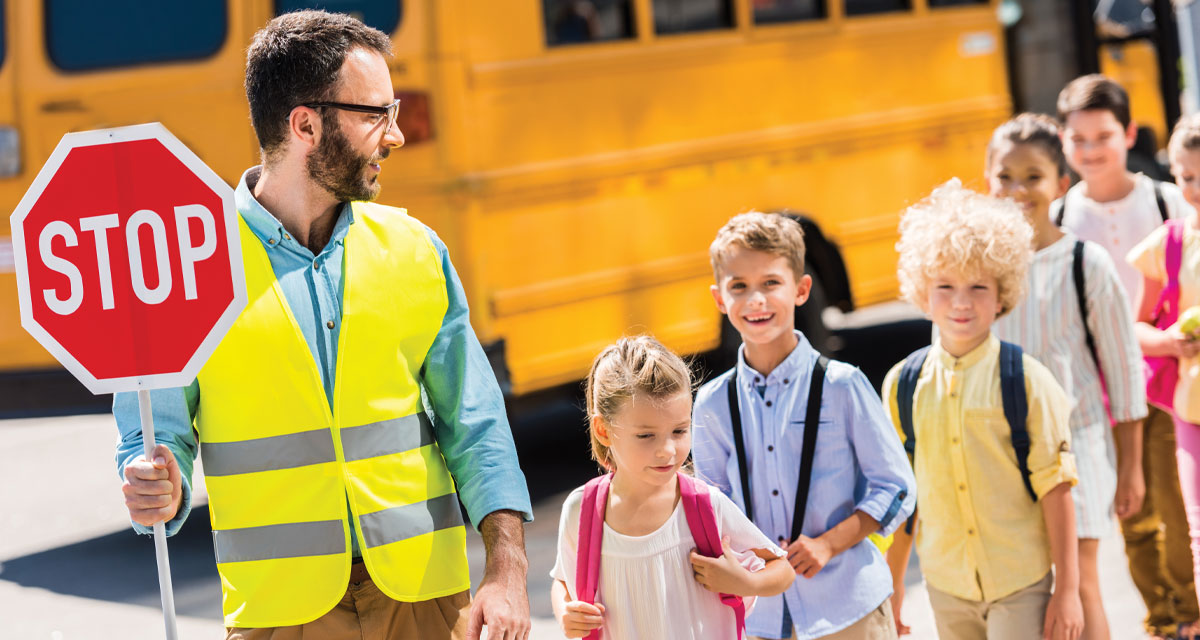Each month this series will provide important facts and tips surrounding child safety in an effort to support parents and caregivers as they navigate reducing risks and creating the safest environment possible for the children in their lives.
As students head back to school for what we hope is an incredible new year, it’s a perfect time to remind both children and adults about transportation safety. No matter how your students are traveling to and from school and extracurricular activities, it’s important to understand potential risks and how to navigate them to ensure a safe and healthy school year for everyone.
School Bus Safety
According to the NHTSA (National Highway Traffic Safety Administration), Students are about 70 times more likely to get to school safely when taking a bus instead of traveling by car. That’s because school buses are the “most regulated vehicles on the road.” In fact, the highest risk to bus riders doesn’t happen while they are being transported, but while approaching or leaving a bus. It’s important to teach students the proper way to wait for the school bus. Waiting doesn’t include running or playing around near the street, but standing patiently and not approaching the doors until the bus comes to a complete stop. When crossing the street, always walk in front of the school bus and never behind it. If your child drops something or leaves an item behind on the bus, they should tell the bus driver or their caregiver, instead of trying to get it themselves. as the driver may not see them.
Safety precautions should be closely monitored by adults, as well. Make sure to pay attention when driving through school zones or passing bus stops, keeping an eye out for children. When you see a school bus, always obey traffic laws; the NHTSA reminds motorists that they must stop and wait for red flashing lights to stop and the extended stop-arm to return back up, before beginning to drive again.
Carpool Safety
While driving your own students to school each day may seem not to require any particular safety measures outside of the usual road safety, there are a few important things to think about. The close quarters of your student’s school pickup-and drop-off lanes can be hazardous, with accidents occurring not only between vehicles, but pedestrians. Remember to monitor distractions when you are behind the wheel by keeping your phone out of your hands and music to a volume that doesn’t cloud your senses. In order to decrease your chance of an accident, be cautious of children darting in and out of traffic and watch for other cars possibly making quick movements to get to their own children or exits.
Walking & Biking Safety
Those families who live within a short distance to school may opt for more environmentally friendly and independent methods of transportation, like walking or biking. While these transportation methods offer great exercise, having repetitive conversations with your students about safety measures for these choices is crucial. Make sure these options are reserved for older children with the maturity to understand and follow all traffic laws. Remind them always to use crosswalks and sidewalks, as well as to pause at curbs and look left-right-left before crossing. If sidewalks are unavailable for the duration of their commute, encourage them to walk facing traffic, so they can see if they need to get out of the way at any time. Dressing your walking or biking kids in bright colors or having them wear a neon vest for commuting purposes can help cars spot them easily, adding a layer of safety. If you have a child with a cellphone, perhaps have them text you each day when they arrive to and from school safely.
Weather Preparedness
Once the school year is in full swing, it can be easy to forget about simple things like checking the weather when you have a family always on the go! Depending on the weather outside, you may need to switch transportation arrangements for the day, such as bikers taking the bus or walkers getting a ride, instead. If you have children who will be outside for extended periods of time for their commute, consider putting sunscreen on them and making sure they have water. If it’s raining or windy, advise them to stay dry with a raincoat or umbrella. Always avoid unnecessary contact with the elements that could lead to sickness or injury and put safety first when deciding on transportation for the day.
Taking Action If Injury or Accidents Occur
Always have a small, age-appropriate First-Aid kit easily accessible for commuting students in their backpack or gym bag. If your child has special medical needs, include any important documents, such as lists of medications they’re currently taking and phone numbers for emergency contacts. Share with your child that if they are unsure about the severity or care of an injury but have concern, always to tell an adult.
Helpful Resources to Learn More:
- Winston-Salem/Forsyth County Schools Bus Safety – www.www.wsfcs.k12.nc.us {ONLINE ARTICLE HYPERLINK: https://www.wsfcs.k12.nc.us/Page/79147}
- NHTSA Road Safety – www.nhtsa.gov/road-safety {ONLINE ARTICLE HYPERLINK: https://www.nhtsa.gov/road-safety }



















